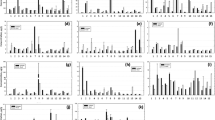Abstract
Brown trout, Salmo trutta, were exposed to water containing 0.1 μg/l 203Hg2+, alone or with potassium ethylxanthate (PEX), sodium isopropylxanthate (SIX), sodium diethyldithiophosphate (SEP), sodium diisopropyldithiophosphate (SIP), sodium dimethyldithiocarbamate (SMC), sodium diethyldithiocarbamate (SEC) or sodium pyridinethione (SPyr), respectively. After 1 week the uptake and distribution of the 203Hg2+ in the fish were examined by gamma spectrometry. SIX, SIP, SMC, SEC and SPyr induced 2–3 times higher 203Hg2+ concentrations in most tissues in comparison with trout exposed to 203Hg2+ only. In the trout exposed to PEX slightly enhanced 203Hg2+ levels were found only in some tissues, and after exposure to SEP a few tissues showed decreased 203Hg2+ concentrations. Determinations of chloroform/water partition coefficients showed that lipophilic chelates are formed between all the examined substances and the 203Hg2+. However, SIX, SIP, SMC, SEC and SPyr, which induced markedly increased tissue levels of the metal, formed 203Hg2+ complexes with higher lipophilicities than SEX and SEP. A facilitated penetration of the lipophilic 203Hg2+ complexes over the gill membranes may underly the increment in the tissue levels of the metal, and the relative lipophilicity of the complexes may be of importance for this effect. In some instances, as with SEP, the 203Hg2+ chelated in complexes with low lipophilicity may even be less able to acumulate in some tissues than the non-complexed metal.
Similar content being viewed by others
References
Aaseth J, Alexander J, Wannag A (1981) Effect of thiocarbomate derivatives on copper, zinc and mercury distribution in rats and mice. Arch Toxicol 48: 29–39
Arnold AP, Canty AJ, Moors PW, Deacon GB (1983) Chelation therapy for methylmercury(II)poisoning. Synthesis and determination of solubility properties of MeHg(II)complexes of thiol and dithiol antidotes. J Inrog Biochem 19: 319–327
Berlin M (1986) Mercury. In: Friberg L, Nordberg GF, Vouk V (eds) Handbook on the toxicology of metals, 2nd edition. Elsevier Science Publishers B. V. pp 387–445
Berlin M, Ullberg S (1963) Increased uptake of mercury in mouse brain caused by 2,3-dimercaptopropanol. Nature 197: 84–85
Bertills U, Björklund I, Borg H, Hörnström E (1986) Biological effects of xanthates. Report No 3112 from the National Swedish Environment Protection Board, Solna, Sweden
Black JG, Howes D (1979) Toxicity of pyrithiones. Toxicology Annual 3: 1–26
Borg K, Tjälve H (1988) Effect of thiram and dithiocarbamate pesticides on the gastrointestinal absorption and distribution of nickel in mice. Toxicol Lett 42: 87–98
Cantilena LR Jr, Irwin G, Preskorn S, Klaassen CD (1982) The effect of diethyldithiocarbamate on brain uptake of cadmium. Toxicol Appl Pharmacol 63: 338–343
Canty AJ, Marker A (1976) Methylmercury(II) derivatives of pyridine-2(1H)-thione. Aust J Chem 29: 1383–1387
Chadwick DH, Watt RS (1961) Dithiophosphates. In: van Wazer JR (ed) Phosphorus and its compounds, Vol II. Interscience Publishers, Inc., New York, pp 1262–1267
Gottofrey J, Björklund I, Tjälve H (1988a) Effect of sodium isoprophylxanthate, potassium amylxanthate and sodium diethyldithiocarbamate on the uptake and distribution of cadmium in the brown trout (Salmo trutta). Aquatic Toxicol 12: 171–184
Gottofrey J, Borg K, Jasim S, Tjälve H (1988b) Effect of potassium ethylxanthate and sodium diethyldithiocarbamate on the accumulation and disposition of nickel in the brown trout (Salmo trutta). Pharmacol Toxicol 63: 46–51
Jasim S, Tjälve H (1984) Effect of sodium diethyldithiocarbamate on placental passage and foetal distribution of cadmium and mercury in mice. Acta Pharmacol Toxicol 55: 263–269
Jasim S, Tjälve H (1986a) Effect of sodium pyridinethione on the uptake and distribution of nickel, cadmium and zinc in pregnant and non-pregnant mice. Toxicology 38: 327–350
Jasim S, Tjälve H (1986b) Mobilization of nickel by potassium ethylxanthate in mice: Comparison with sodium diethyldithiocarbamate and effect of intravenous versus oral administrations. Toxicol Lett 31: 249–255
Jasim S, Danielsson BRG, Tjälve H, Dencker L (1985) Distribution of 64Cu in foetal and adult tissues in mice: influence of sodium diethyldithiocarbamate treatment. Acta Pharmacol Toxicol 57: 262–270
Lindqvist O, Jernelöv A, Johansson A, Rodhe H (1984) Mercury in the Swedish Environment. Report No. 1816 from the National Swedish Environment Protection Board, Solna, Sweden
Olson KR, Bergman HL, Fromm PO (1973) Uptake of methyl mercury chloride and mercuric chloride by trout: a study of uptake pathways into the whole animal and uptake by erythrocytes in vitro. J Fish Res Board Can 30: 1293–1299
Oskarsson A, Lind B (1985) Increased lead levels in brain after long-term treatment with lead and dithiocarbamate or thiuram derivatives in rats. Acta Pharmacol Toxicol 56: 309–315
Oskarsson A, Tjälve H (1980) Effects of diethyldithiocarbamate and penicillamine on the tissue distribution of 63NiCl2 in mice. Arch Toxicol 45: 45–52
Rao SR (1971) Xanthates and related compounds. Marcel Dekker, Inc., New York
Schanker LS (1962) Passage of drugs across body membranes. Pharmacol Rev 14: 501–550
Sun P-J, Fernando Q, Freiser H (1964) Structure and behavior of organic analytical agents. Formation constants of transition metal complexes of 2-hydroxypyridine-1-oxide and 2-mercaptopyridine-1-oxide. Anal Chem 36: 2485–2488
Thorn GD, Ludwig RA (1962) The dithiocarbamates and related compounds. Elsevier Publishing Company, New York
Winter G (1980) Inorganic xanthates. Rev Inorg Chem 2: 253–342
Author information
Authors and Affiliations
Rights and permissions
About this article
Cite this article
Borg, K., Gottofrey, J. & Tjälve, H. Effects of some chelating agents on the uptake and distribution of 203Hg2+ in the brown trout (Salmo trutta): studies on ethyland isopropylxanthate, diethyl- and diisopropyldithiophosphate, dimethyl- and diethyldithiocarbamate and pyridinethione. Arch Toxicol 62, 387–391 (1988). https://doi.org/10.1007/BF00293628
Received:
Accepted:
Issue Date:
DOI: https://doi.org/10.1007/BF00293628




